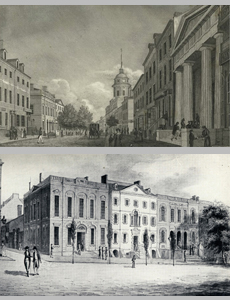The Skyscraper Museum is devoted to the study of high-rise building, past, present, and future. The Museum explores tall buildings as objects of design, products of technology, sites of construction, investments in real estate, and places of work and residence. This site will look better in a browser that supports web standards, but it is accessible to any browser or Internet device.
MANSIONS AND BANKS

Top: Moses King, King's Views of New York Stock Exchange, pg. 67.
Bottom: Henry Wysham Lanier, A Century of Banking in New York 1822-1922, 1922, pg. 71.
In the late 18th and early 19th century, the blocks between City Hall/ Federal Hall and the active commerce of the East River port filled in with a continuous row of handsome residential buildings. With the seat of the federal government located in Pierre L'Enfant's newly expanded Federal Hall, the area became the center of political activity and a highly coveted address for government functionaries, foreign dignitaries, civic leaders, and businessmen. The city's elite paraded past elegant dwellings and the imposing public edifices that made Wall Street a magnet of high society.
Mansions soon gave way to the commercial impulses of the street, though, even as the outward residential architecture persisted for a brief period. The first bank established in the city, as well as the first to locate on Wall Street, was the Bank of New York, which was organized in 1784 and moved to the northeast corner of William Street in 1797 (in the building at the left of the lower image). Adjoining it to the east (right), was the New York Insurance Company, which operated from the residence of the company's president Charles McEvers.
With the monumental presence of the new Merchants' Exchange, designed by Martin E. Thompson and completed in 1827 (its raised dome is visible in the image above), Wall Street began its first transformation into a corridor of purpose-built bank buildings. The first generation of the dominant style of Greek Revival temples and treasuries included Thompson's 1824 Branch Bank of the United States and the Phenix Bank at 45 Wall, visible at the right of the foreground.
